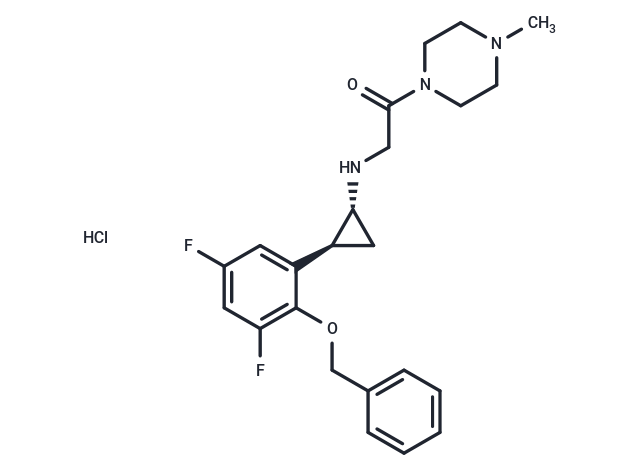Shopping Cart
Remove All Your shopping cart is currently empty
Your shopping cart is currently empty
S2157, a potent N-alkylated tranylcypromine (TCP) derivative lysine-specific demethylase 1 (LSD1) inhibitor, enhances H3K9 methylation and concurrently reduces H3K27 acetylation at super-enhancer sites. This compound triggers apoptosis in TCP-resistant T-cell acute lymphoblastic leukemia (T-ALL) cells by inhibiting NOTCH3 and TAL1 gene expression. Moreover, S2157 is capable of crossing the blood-brain barrier, effectively eliminating central nervous system (CNS) leukemia in mice models implanted with T-ALL cells.


| Description | S2157, a potent N-alkylated tranylcypromine (TCP) derivative lysine-specific demethylase 1 (LSD1) inhibitor, enhances H3K9 methylation and concurrently reduces H3K27 acetylation at super-enhancer sites. This compound triggers apoptosis in TCP-resistant T-cell acute lymphoblastic leukemia (T-ALL) cells by inhibiting NOTCH3 and TAL1 gene expression. Moreover, S2157 is capable of crossing the blood-brain barrier, effectively eliminating central nervous system (CNS) leukemia in mice models implanted with T-ALL cells. |
| In vitro | S2157 demonstrates notable efficacy against T-cell acute lymphoblastic leukemia (T-ALL) cell lines, with IC 50 values ranging from 1.1 μM in the CEM cell line to 6.8 μM in the MOLT4 cell line[1]. At concentrations between 4-20 μM over a 72-hour period, S2157 modestly inhibits the proliferation of mitogen-activated normal T-lymphocytes[1]. Furthermore, treatment with S2157 at doses of 4-8 μM for 24 hours leads to the induction of apoptosis in T-ALL cells and the reduced expression of NOTCH3 and TAL1 proteins, crucial markers involved in the disease's progression[1]. This activity is evidenced by increased annexin-V reactivity in flow cytometry analyses and confirmed through Western blot analysis, respectively, indicating a dose- and time-dependent effect without influencing the cell cycle distribution[1]. |
| In vivo | Administration of S2157 at a dosage of 50 mg/kg intraperitoneally (IP) three times a week for 28 days significantly reduces the size of subcutaneous tumors to less than 20% compared to untreated controls in Nonobese diabetic/severe combined immunodeficiency (NOD/SCID) mice implanted with MOLT4 cells. Moreover, at dosages of 30 mg/kg or 50 mg/kg, administered twice a week for three weeks, S2157 almost entirely suppresses the growth of MOLT4 cells in the majority of NOD/SCID mice, though not in all cases. Furthermore, S2157 effectively eradicates Central Nervous System (CNS) leukemia in murine xenotransplanted models. In pharmacokinetic analysis on 8-week-old ICR mice given a single dose of 50 mg/kg IP, S2157 exhibits a half-life (T 1/2) of 0.88 hours, a maximum concentration (C_max) of 4.33 μM, and an area under the curve (AUC) of 5.75 μM·h. |
| Synonyms | S2157 |
| Molecular Weight | 451.94 |
| Formula | C23H28ClF2N3O2 |
| Cas No. | 2262488-39-9 |
| Smiles | Cl.CN1CCN(CC1)C(=O)CN[C@@H]1C[C@H]1c1cc(F)cc(F)c1OCc1ccccc1 |
| Relative Density. | no data available |
| Storage | Powder: -20°C for 3 years | In solvent: -80°C for 1 year | Shipping with blue ice/Shipping at ambient temperature. |
| Size | Quantity | Unit Price | Amount | Operation |
|---|

Copyright © 2015-2026 TargetMol Chemicals Inc. All Rights Reserved.